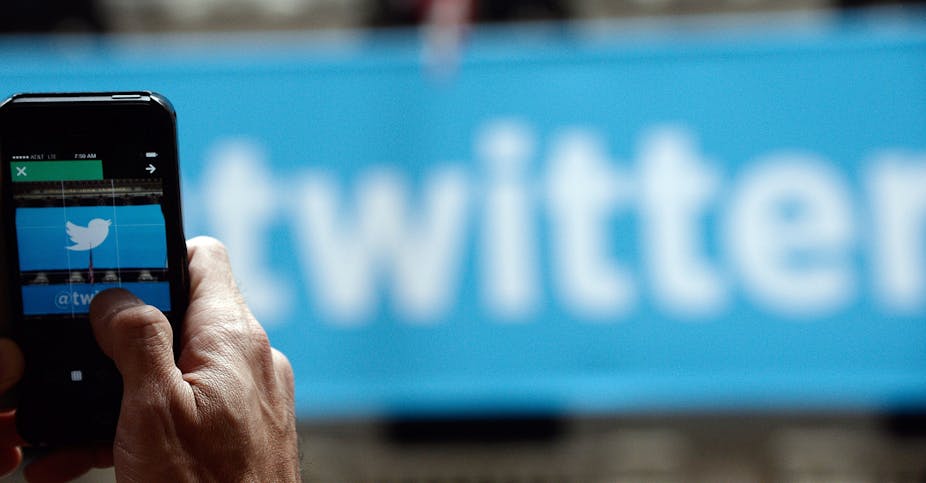UPDATED MARCH 27, 11:45AM AEDT: Mike Baird’s Liberal National coalition government has dominated the campaign conversation on Twitter.
Using Hypometer™ technology, we have been tracking the NSW election in real time and publishing infographics on:
- the volume of posts (including which parties have been most active)
- how often the Liberal and Labor parties are being mentioned on Twitter
- and, for the first time, we are tracking the average sentiment expressed about six different political parties, including trending hashtags.
We have embedded those infographics into this article, and they will keep updating every five minutes with the latest social media data. You can keep seeing the latest results right through to polling day this Saturday.
How much people are tweeting about the Liberals v Labor
Overall, the volume of Twitter conversation mentioning the parties has been fairly consistent at around 200-250 posts per hour, peaking at around 400-500 per hour each evening. The biggest spikes in activity on March 8 and 13 related to the election debates. Earlier spikes related to the announcement of the election.

The seven parties tracked above are, in order, the Liberals, Labor, the Nationals, the Greens, Christian Democratic Party, Shooters and Fishers Party and the Country Labor Party.
As with the Queensland election, the minor parties in NSW have been playing a very small role in overall conversation. For much of the campaign, the Nationals have seen just 5% of the conversation, dropping to 4% for the Greens, and 1-2% for the other parties. (This may change in the final days of the campaign: the infographic below shows the latest results.)

As the campaign has progressed, the balance of conversation across the two major parties shifted somewhat more towards Labor, although this came at the expense of the minor parties rather than conversation around the Liberals. Discussion of the Liberal Party has largely held steady at around 55% of the total party-related conversation.
We saw similar patterns before January’s state election in Queensland, where the majority of pre-election Twitter chatter focused on the Liberal National government, but that government was later narrowly defeated.
In both Queensland and NSW, it’s the incumbent effect at work, where people are more likely to be talking about the current government, in both positive and negative ways.
Tracking sentiment
For the first time, we have also been using Hypometer technology to track sentiment during the campaign. A single tweet on its own tells us little, but aggregating the tweets relating to each of the parties on each day may generate a better picture of overall sentiment.
Early analysis indicates that such sentiment shifts rapidly from day to day and can be heavily influenced by external events. For example, the shift in tone of those discussing the Liberal Party has, at times, been affected significantly by events at the federal level – especially early in the campaign when there was still speculation about a leadership spill.

Green indicates more positive Twitter comments, while red is for more negative. The parties listed, in order, are the Liberals, Labor, the Nationals, the Greens, Christian Democratic Party, Country Labor Party.
Hot topics
State-level policies are still influential in the overall conversation. To date, the most prominent trending hashtags in our data set – ignoring generic hashtags such as #nswvotes and #nswpol – have largely related to specific events.
For example, on March 19 #balmainforum was among the most popular Twitter topics in Sydney, as the Greens’ Jamie Parker and the ALP’s Verity Firth battled it out in a debate for the inner-west Sydney seat of Balmain.
But some competing party policies on specific issues have also cut through with particular hashtags, including such #nswnotforsale for electricity privatisation and #csg for coal seam gas, as well as #pilliga (a reference to coal seam gas exploration in the Pilliga Forest).
The benefit of incumbency
Overall, social media patterns cannot tell us who is going to win the NSW election, nor can social media necessarily decide the election.
And of course it should be noted that the Twitter conversation covers only part of the overall public debate. Twitter’s demographics in Australia skew towards a 25- to 55-year-old, urban, educated group, which tends to be influential in public debate, but does not represent everybody. What our research reveals should therefore be seen within a wider context of public debate and discussion.
However, our observations to date confirm the benefit of incumbency and provide a useful indication of the changes in discussion around the parties, in both volume and sentiment, throughout the campaign.
Read more of The Conversation’s coverage of the 2015 NSW election.

